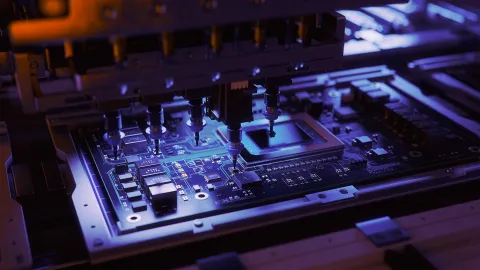Building the business case for payments modernization

Payments modernization isn’t just for fintechs. It’s become a must for banks and financial services of all sizes to remain competitive. This article explores the strategic business case model underpinning payments modernization, and considers why addressing aging legacy systems is critical for successful financial services modernization, as well as meeting evolving customer demands.
Why payments modernization can’t wait
Real-time capabilities, regulatory pressures and evolving customer expectations are pushing financial institutions (FIs) to review their payments infrastructure. Aging legacy systems have now become a particular barrier to agility and innovation. Additionally, new compliance requirements, including increasing adoption of ISO 20022, is driving the need for payments modernization on a global level.
In our article ‘Why can’t payments modernization wait?’, we stress the importance of upgrading outdated systems and that modernization is about building flexibility, resiliency and customer-centricity to avoid falling behind.
To understand the urgency for modernization better, let’s review the two main pressure areas for FIs: market drivers and the opportunity costs of not addressing the limitations of legacy infrastructure.
Drivers behind financial services modernization
There has been a shift in customer expectations with the demand for seamless, real-time omnichannel, and contextual payment experiences. Fintech disruptors and neobanks are capturing market share by offering customers new services faster and more cost-effectively than traditional banks. What’s more, they’re leveraging modern, cloud-native platforms that offer enhanced capabilities, benefiting their customers and increasing their own operational efficiency.
Opportunity cost of inaction in addressing legacy payment systems
Operational inefficiencies and lack of modularity in legacy payment systems contribute to delays, higher error rates and siloed data, making it difficult for FIs to deliver unified customer experiences, scale quickly or provide actionable data insights.
Other impacts include delayed time to market for new services, potential gaps in security and IT teams burdened with legacy maintenance compromising innovation opportunities.
Key business benefits of modern payment systems
Besides avoiding opportunity costs associated with outdated infrastructure, there are other opportunities in adopting more modern payment systems.
Accelerated time to market and faster innovation
Modern payment systems are modular, offering FIs the opportunity to develop granular innovations and solutions for customers. Additionally, these solutions are based on industry best practices, including working in compliance with payment schemes and market regulations.
Such modern systems leverage microservices and APIs to rapidly launch new payment schemes (domestic and cross-border) and associated services. Using cloud-native technologies, along with agile methodologies and processes, modern solutions also avoid traditional waterfall development cycles, providing speedier, lower-risk and lower-effort deployments.
Risk reduction, compliance and regulation in digital transformation
Modern payment systems are based on robust security standards, offering on-demand scalability, ongoing compliance, 24/7 availability and high resiliency backed by proven disaster recovery capabilities. We explored these advantages in our webinar ‘Think about long-term payment modernization, not just short-term compliance’, focusing on how strategic investment is necessary for FIs to balance speed, security and compliance while supporting real-time payments - including readiness for generative Artificial Intelligence, messaging technologies, digital currencies and cross-border payment networks.
To manage regulatory complexity, especially around mandates like ISO 20022 and PSD3, modern payment systems are built with faster compliance and transparency as standard, and with pre-configured modules to help FIs meet global anti-money laundering (AML) and Know Your Customer (KYC) requirements.
Modern payment systems follow an ethos of “configuration not customization”, meaning new payment rails or other changes can be introduced through business rules and standardized workflows as opposed to expensive and higher-risk code changes. This agility also ensures FIs and banks are no longer stuck with outdated systems and growing technical debt. Having an API-first and microservices-based architecture also makes the overall system integration exercise simple, faster, safer and cost-efficient.
Simplification and cloud-based payment platforms
Leading payments technology providers are offering framework-based approaches that enable banks and FIs to consume complete payment hubs or standalone business packages depending on their strategic needs. This approach offers the flexibility to select the right fit and deploy on any chosen cloud platform, on-prem, or as-a-service, ensuring faster time-to-value and business agility. What’s more, switching to cloud-based payment solutions and replacing aging legacy systems, reduces the burden on IT maintenance and management teams.
Finastra's cloud-based payment solutions, Global PAYplus and Payments To Go, are underpinned by our bespoke Global Payments Framework, which allows banks and FIs to modernize payments on their terms with peace of mind.
Lower total cost of ownership through modernization
Payments modernization lowers costs in several ways:
- Cloud-based platforms use CI/CD pipelines and offer infrastructure capabilities to maintain a 24/7 available system at competitive pricing.
- Modern payment systems offer scalable resources that adjust based on usage, ensuring FIs only pay for what they use, thereby reducing operational and maintenance costs.
- API-based design and an agile architecture offer rapid innovation opportunities without having to overhaul the entire system.
Payments modernization as business process transformation
Achieving true payments modernization requires strategic business changes, approaching it as a business process evolution that aligns technology, operational efficiencies and a measurable ROI.
Aligning modernization with business strategy
Modernization serves a purpose greater than just technology, but rather also supports a bank's mission, goals and market positioning. Creating a valid business case for payments modernization requires aligning payment operations objectives with true strategic goals, which should involve re-evaluating business processes as opposed to simply porting existing ones to new technology.
Examples of such objectives could include incorporating instant payments and request-to-pay capabilities to enhance customer experience and automate payment journeys to reduce manual intervention and operational risks. Achieving this alignment with the business strategy requires close, cross-functional collaboration between IT, product, risk and compliance and management teams.
Change management, in particular, plays a critical role in payments modernization. Through collaboration, IT and management teams can drive scalable, sustainable change. As noted by Ellucian:
“The importance of alignment is that it allows you to make a much stronger case for change right from the beginning. Business and IT alignment leads to more effective performance and use of technology, while a lack of alignment tends to lead to inefficient use of funds, time, and missed goals.”
Subject matter experts who manage existing legacy payment systems can help evaluate migration risks, from compliance to integration dependencies and post-deployment support. Their expertise can strengthen the digital transformation ROI case, identifying and addressing operational bottlenecks, compliance gaps and workflow delays.
Strategic approaches and the modernization roadmap
By starting with high-priority use cases, banks and FIs can pursue incremental modernization, which breaks down the endeavour into smaller, less cost/risk-intensive parts. A clear modernization roadmap is critical for aligning the relevant stakeholders. Some key points to consider:
- Subject matter experts from the FI need to be engaged regarding the maintenance and operation of legacy payment systems. This ensures a thorough assessment of system dependencies, risks and integration requirements.
- Link every incremental modernization endeavour to clear business outcomes. This is key to securing budget and executive support under a business case model.
- Use subject matter experts from the FI and vendors to identify expected outcomes against which to measure quantifiable ROIs. This includes expected reduction in maintenance costs, timelines and manual processing.
To measure the success of payments modernization, some key ROI metrics need to be used:
- Enhanced cost-per-transaction: Cloud-based payment solutions have the ability to process transactions with greater speed and automated validation, meaning banks and FIs can benefit from more earned fees and favorable pricing from vendors.
- Improved SLA compliance: Modern payment systems allow banks to better meet agreements around processing times, accuracy and availability.
- IT and infrastructure cost savings: Maintenance and upgrade costs are reduced by retiring aging legacy systems that hinder performance.
- Speed to launch new services and features: Using solutions like Finastra Global PAYplus or Payments To Go enables rapid deployment of new services and products, offering a competitive advantage.
Finastra’s payment hub solutions have demonstrated real-world improvements in all these areas.
Real‑world results from mid‑tier banks
Our whitepaper, ‘The importance of modernization for mid-tier US banks’, explores how modern payment hubs are crucial to enhance service offerings, strengthen client relationships and secure market positioning in a competitive space.
U.S. mid‑tier banks have shown great results through targeted, incremental modernization. Findings from Finastra and Datos Insights reveal that 96% of banks are investing significantly in payments modernizations, with 80% seeing legacy systems as a major block to innovation. For most mid-tier organizations, the ability of a vendor to offer a Payments-as-a-Service (PaaS) deployment option (such as Finastra’s Payments To Go) is key in their decision-making, as this aligns well with their budgets, needs, and IT capacity.
Read the paper to understand how to achieve better client relationships through automation, transparency and agility.
Make the case for payments modernization with confidence
Payments modernization is a strategic opportunity for all sizes of FIs. A modern payment hub solution enables them to optimize and improve processes, reduce duplication of efforts and increase payment processing automation. In turn, benefits like increased operational efficiency, reduced TCO, improved risk management, and enhanced customer experiences will follow.
Solutions like Finastra Global PAYplus and Finastra Payments To Go, centered on the Global Payments Framework, offer unmatched scalability and resiliency, delivering rapid ROI to banks on their modernization roadmap. Backed by an experienced team with extensive, global digital transformation expertise, Finastra offers a pathway for FIs to transform payment systems confidently and sustainably.



